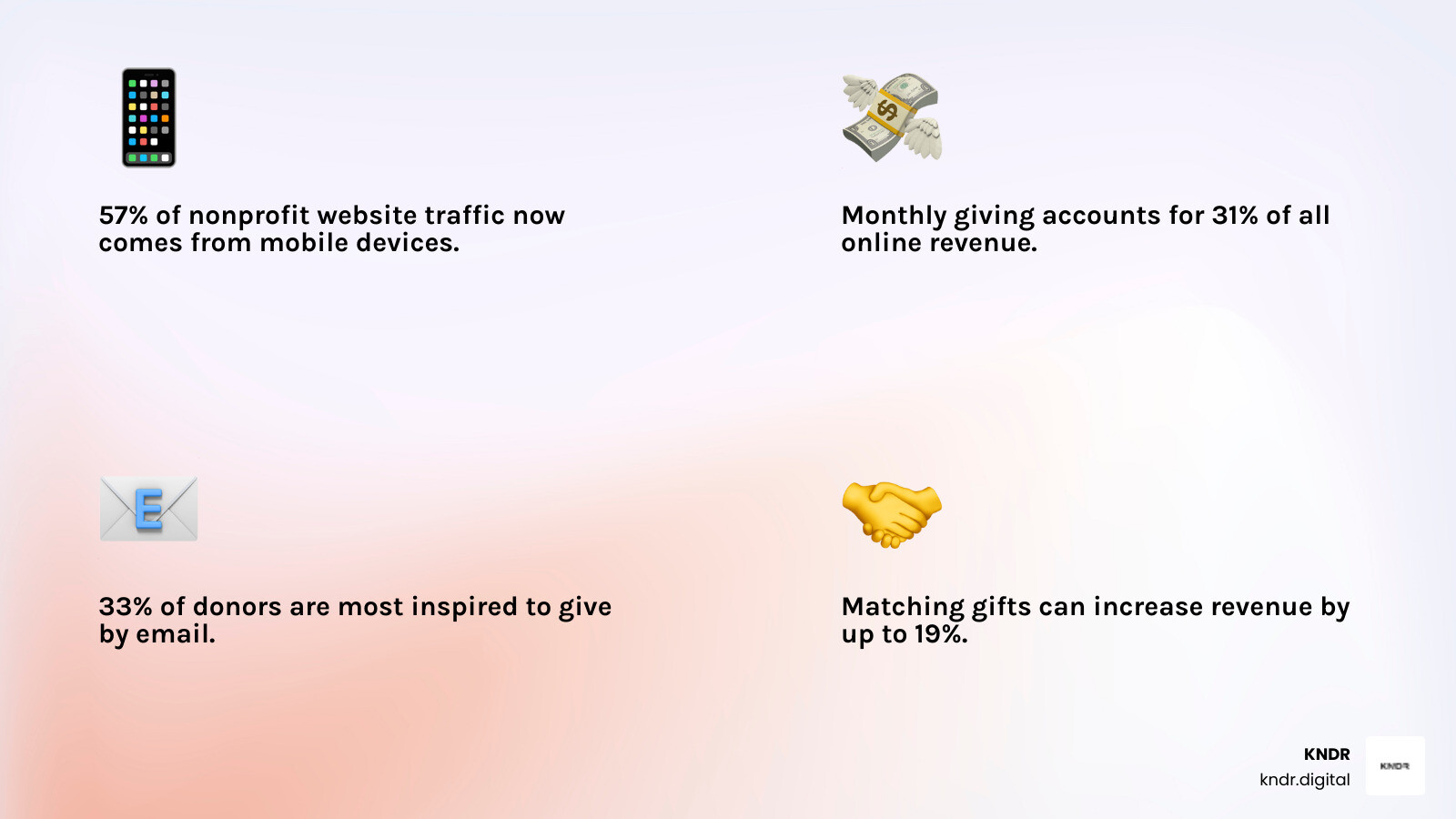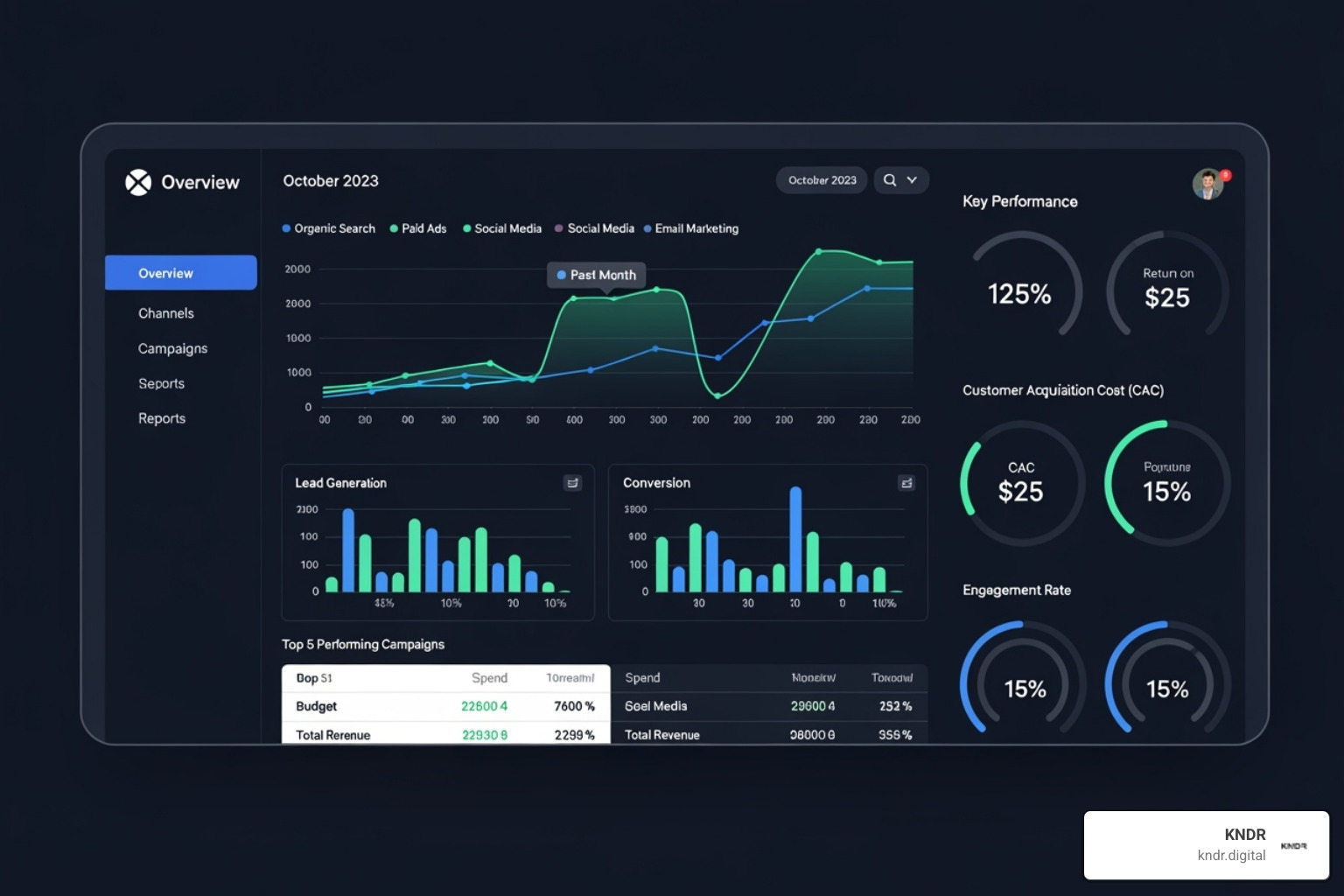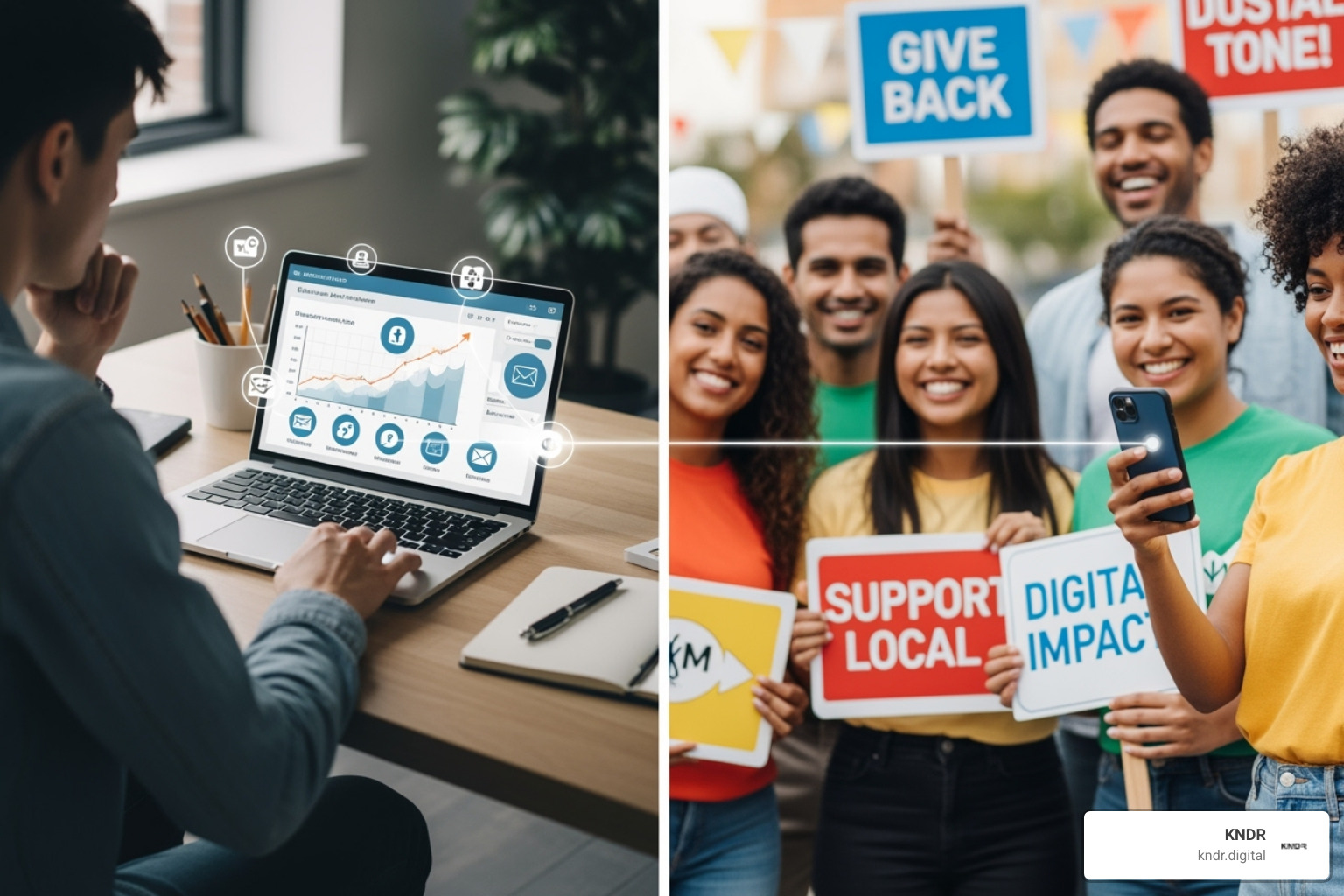Your Nonprofit's Guide to Digital Fundraising Gold

Why Digital Fundraising is a Game-Changer for Nonprofits
Digital fundraising best practices are the proven strategies nonprofits use to raise money online. This includes everything from optimizing donation pages and launching email campaigns to leveraging social media and implementing AI-powered personalization.
Key strategies include building a mobile-optimized donation page, segmenting your audience for personalized outreach, promoting monthly giving, using matching gifts, and tracking key metrics like donor retention.
The shift to digital is about survival. In-person events can cost up to 75 cents of every dollar raised, while digital fundraising eliminates venue and printing costs. More importantly, it lets supporters give anywhere, anytime. With 57% of nonprofit website traffic coming from mobile devices and 12% of total revenue from online sources, your donors expect digital options.
The landscape has evolved. Monthly giving now accounts for 31% of all online revenue, and over $6 billion has been donated through Facebook and Instagram fundraising tools alone. Digital isn't just about lower costs; it's about real-time engagement. You can thank donors instantly, share impact stories, and adjust your messaging on the fly, building lasting relationships that drive sustainable growth.
I'm Mahir Iskender, founder and CEO of KNDR.digital, where I've helped dozens of nonprofits transform their fundraising through AI-powered marketing systems. I've seen how these best practices don't just increase donations—they fundamentally change how nonprofits connect with their communities and scale their impact.

Terms related to Digital fundraising best practices:
- Nonprofit digital marketing
- Nonprofit marketing consultant
- digital marketing transformation consultant
Foundational Digital Fundraising Best Practices
Before launching campaigns, you need a rock-solid foundation. These foundational digital fundraising best practices are the infrastructure that supports everything else. Without them, even the most creative campaigns will struggle.
1. Master the 4-Step Campaign Framework
Successful digital fundraising guides supporters on a journey. This journey breaks down into four essential steps: Attract, Nurture, Convert, and Retain.
- Attract: Capture attention with compelling content on social media, blogs, and digital ads. The goal is to make people notice you and want to learn more.
- Nurture: Build trust by sharing impact stories and educational updates. Show the difference your work makes without asking for a donation.
- Convert: Make the donation request to an audience that already understands and trusts your mission. Make giving easy with personalized asks and recurring donation options.
- Retain: Thank donors promptly and share ongoing impact stories to transform one-time givers into lifelong supporters.
Strategic planning around these four phases builds donor relationships, not just transactions. For more on managing these campaigns, see our guide on Fundraising Campaign Management.
2. Build a High-Converting Online Donation Page
Your donation page is the single most important digital asset for your nonprofit. It needs to be clear, simple, and trustworthy.
- Mobile-First Design: With 28% of online donations happening on mobile, your page must be flawless on every screen.
- Simplicity: Only request essential information: name, email, and payment details. Fewer clicks lead to more completed donations.
- Suggested Giving Amounts: Guide donors with donation levels tied to specific outcomes (e.g., "$50 provides school supplies for one child").
- Recurring Gift Option: Make the monthly giving option prominent. Monthly donors are more valuable over time.
- Impact Statements: Weave in specific examples of what a donation will accomplish to show tangible results.
- Branding: Use consistent colors, logos, and messaging to build trust and confidence.
- Payment Options: Offer multiple methods like credit cards, PayPal, Apple Pay, and Google Pay.
An optimized page creates an experience that makes donors feel good about giving. Dive deeper with our guide on Landing Page Optimization for Non-Profit Organization Success.
3. Leverage a CRM for Smarter Donor Management
A CRM (Customer Relationship Management) platform is the central nervous system of modern digital fundraising.
It provides centralized donor data—contact details, giving history, and communication preferences—and allows for sophisticated relationship tracking to see every touchpoint with each donor. The automation benefits are significant, freeing up your team by automatically sending thank-you emails, welcoming new subscribers, and triggering messages based on donor actions.
Most importantly, a CRM's segmentation capabilities allow you to group your donor database by donation amount, frequency, location, and interests to power personalized communication. Finally, reporting and analytics turn your data into actionable insights to track campaign performance and identify trends.
Investing in a CRM is about building stronger, more meaningful relationships. Explore options in our guide to Charity CRM Solutions.
High-Impact Campaign Strategies to Boost Donations
With a solid foundation, you're ready to launch campaigns that transform sporadic giving into sustained support.

4. Launch a Powerful Monthly Giving Program
If you focus on one thing, make it a monthly giving program. It creates financial stability and donor loyalty. Monthly giving provides a steady, reliable revenue stream, allowing you to plan for the future. Monthly donors contribute an average of $888 per year, and this type of giving now accounts for 31% of all online revenue.
Monthly donors also have a much higher lifetime value and are more likely to become passionate advocates. To build your program, create a dedicated landing page and promote it everywhere. A pop-up on your one-time donation page can increase monthly donations by 24%. You're inviting them to become partners in your mission. Learn more about streamlining this process in our guide on an Automated Donation System.
5. Harness the Power of Peer-to-Peer and Community Fundraising
39% of Americans say they've donated to a charity because of a request from a friend or family member. Peer-to-peer (P2P) fundraising taps into this power by turning your supporters into fundraisers.
This approach empowers your community to create their own fundraising pages and reach their networks, opening doors to new donor pools. To ensure success, provide your fundraisers with a toolkit containing branded images, social media templates, and key facts about your mission. P2P works especially well for specific projects or events like marathons or birthday fundraisers. Support your fundraisers throughout their campaigns to show they're not alone. For a deeper dive, explore our guide on Peer-to-Peer Fundraising Nonprofit.
6. Maximize Revenue with Matching Gifts and Giving Days
An estimated $4-$7 billion in matching gifts goes unclaimed each year because donors don't know their employer will match their donation. This unclaimed money can boost your revenue by up to 19%.
Make it easy for donors to find this option. Include a matching gift tool on your donation page and in confirmation emails. Promote these opportunities to increase revenue without acquiring new donors.
Giving days like Giving Tuesday create urgency and excitement. Giving Tuesday alone generated $3.1 billion in the U.S. in 2022. Plan these campaigns in advance with a dedicated landing page, promotional graphics, and early announcements. On the day, post frequently, use a fundraising thermometer to show progress, and send reminder emails. Afterward, send a summary email thanking everyone and showcasing the impact. For more strategies, see our guide on Boosting Nonprofit Donations.
7. Engage Audiences with Virtual Events and eCards
Digital fundraising best practices also include creating memorable experiences. Virtual events are accessible, cost-effective, and can reach a global audience. Think beyond webinars to livestreamed concerts, online auctions, and virtual challenges. The key is to treat them like real events with promotion, interactive elements, and clear calls to action for donations.
Don't overlook eCards, which are highly effective for tribute gifts. 46% of online donors give tribute gifts in honor or memory of someone. An eCard platform lets you design branded cards that spread awareness every time one is sent. You can sell them directly or offer them as a donor perk, especially around holidays. Explore more creative ideas in our guide on Nonprofit Donor Engagement Strategies.
Optimizing Your Strategy with Multi-Channel Communication and AI
To excel in fundraising, you must orchestrate efforts across multiple channels and harness cutting-edge technology like AI.

8. Create a Seamless Multi-Channel Communication Strategy
A critical digital fundraising best practice is creating a unified strategy that meets donors on email, social media, and text with a cohesive message.
- Email marketing is your most powerful channel. 33% of online donors say email most inspires them to give. Effective campaigns segment supporters into groups (new donors, lapsed donors, etc.) to deliver personalized content.
- Social media is for building community, sharing stories, and driving traffic to your donation pages.
- SMS and text messaging are powerful for live events or urgent appeals.
Together, these channels create an integrated donor journey that builds trust and reinforces your mission. For a deep dive into email, explore our Nonprofit Email Marketing Complete Guide.
9. Use Social Media for Community and Conversions
Social media is a vibrant hub for community building and a powerful fundraising tool. 56% of donors inspired by social media say it has the biggest impact on their giving.
- Facebook and Instagram are fundraising powerhouses, facilitating over $6 billion in donations. Their built-in tools make giving effortless, and 89-92% of donors on these platforms say they'd give through them again.
- TikTok offers a unique opportunity to connect with younger supporters, as 60% of its users are Gen Z.
Beyond fundraising tools, build genuine community by sharing behind-the-scenes content and engaging with supporters. Meeting donors where they are converts engagement into vital support. For platform-specific strategies, check out our guide on Social Media for Nonprofits.
10. Employ Advanced Digital Fundraising Best Practices with AI and Segmentation
Combining sophisticated audience segmentation with AI is the future of digital fundraising best practices, allowing for unprecedented personalization.
Go beyond basic demographics to segment audiences by giving history, engagement level, and preferred donation methods, then add AI-powered personalization. AI can analyze data to tailor donation requests based on a donor's past behavior and predicted capacity to give. Predictive analytics can identify which donors are likely to upgrade their gift or become major supporters, allowing for proactive engagement.
AI can also optimize ask amounts by dynamically adjusting suggestions for each donor, maximizing conversion rates. However, AI is a tool that must be used ethically. At KNDR, we prioritize responsible AI, focusing on data ethics, privacy, and security to maintain donor trust. AI-driven systems are changing how nonprofits connect with communities. Explore this field with our guide on AI-Driven Fundraising.
11. Leverage Digital Advertising and Grants
Digital advertising reaches specific audiences with targeted messages. For nonprofits, the Google Ad Grant is a game-changing opportunity, providing $10,000 per month in free Google advertising.
To maximize this grant, be strategic:
- Choose effective keywords relevant to your mission and campaigns.
- Direct ads to relevant, optimized landing pages that match the ad's message.
- Write engaging ad copy with a clear value proposition and a strong call to action.
Beyond the grant, paid digital advertising on platforms like Facebook and Instagram offers powerful targeting. You can reach specific demographics and create lookalike audiences based on your existing donor data to find new supporters. Strategic use of free and paid advertising can significantly expand donor acquisition. Learn more about applying for this resource through the Google Ad Grant.
Measuring Success and Ensuring Long-Term Growth
Launching campaigns is only half the battle. True success comes from learning from results, adapting your approach, and building lasting relationships.
12. Prioritize Donor Retention and Build Trust with Social Proof

The current donor retention rate is a sobering 18.3%, meaning for every 100 donors acquired, 82 are lost by the next year. The solution isn't just acquiring more donors—it's keeping the ones you have. Donor retention must be at the heart of your digital fundraising best practices.
Key retention strategies include:
- A new donor welcome series via email to introduce your mission.
- Annual donation summaries that remind donors of their impact.
- Upgrading one-time donors to monthly givers.
- Regular impact reports showing how money is making a difference.
- Donor surveys to make supporters feel heard and valued.
Trust-building starts from the first interaction, where social proof is powerful. When potential donors see others giving, they are more likely to give. Effective tools include a donation feed or pop-up showing recent gifts, testimonials from donors, and progress bars during campaigns to build momentum. When donors trust you and feel valued, they become true partners. Explore deeper strategies in our Nonprofit Donor Retention Ultimate Guide.
13. Track Key Metrics and Adhere to Legal Guidelines
You can't improve what you don't measure. Successful organizations constantly analyze data to refine their strategy.
Key metrics to track include:
- Conversion Rate: The percentage of visitors who complete a donation.
- Cost per Donation: How much it costs to acquire a single donation.
- Donor Lifetime Value (LTV): The total amount a donor is expected to give over their entire relationship with you. This highlights the importance of retention.
This data reveals your fundraising health. Our Nonprofit Fundraising Performance Metrics Guide offers a comprehensive look at the metrics that matter.
Beyond metrics, operate within legal and ethical boundaries. This includes complying with data privacy laws like GDPR, adhering to PCI DSS standards for credit card processing, providing proper tax receipts, and meeting state registration requirements for soliciting donations. Above all, commit to transparency with your donors about how funds are used and their data is handled. This is the foundation of trust for sustainable growth.
Frequently Asked Questions about Digital Fundraising
Here are answers to the most common questions we hear from nonprofits.
What are the most effective digital channels for fundraising?
While an integrated approach is best, these channels consistently deliver:
- Email Marketing: Remains the champion, with 33% of donors saying it most inspires them to give.
- Social Media: Facebook and Instagram are fundraising powerhouses, with built-in tools that make giving frictionless.
- Your Website: Your donation page is your digital front door. With 57% of traffic from mobile, a mobile-friendly experience is essential.
- Search Engine Marketing: The Google Ad Grant ($10,000/month in free ads) lets you capture donors actively searching for causes like yours.
How can a small nonprofit start with digital fundraising?
If resources are limited, start small:
- Build a simple, mobile-friendly donation page. This is your non-negotiable first step.
- Focus on one or two social media channels where your audience spends their time.
- Build an email list from day one. Add an opt-in form to your site and send regular updates.
- Participate in giving days like Giving Tuesday to leverage existing donor attention.
How do you measure the ROI of a digital fundraising campaign?
Understanding your return on investment (ROI) helps you improve each campaign. The basic formula is: (Total Revenue - Total Costs) / Total Costs.
For example, if a campaign raised $10,000 and cost $2,000, your ROI is 400%. But true insight comes from tracking key metrics like conversion rate, cost per acquisition, and donor lifetime value. The last metric is crucial, as it shows the long-term impact of retention. The more you measure, the more effective your practices become. For a full breakdown, see our guide on Nonprofit Fundraising ROI.
Conclusion: Transform Your Fundraising with a Digital-First Approach
The future of nonprofit fundraising is here, and these digital fundraising best practices make success more accessible than ever.
We've covered foundational strategies, high-impact campaigns like monthly giving, and cutting-edge tools like AI and multi-channel communication.
The data is clear: with donor retention at 18.3% and 57% of traffic from mobile, you can't afford to ignore strategies that build lasting relationships and provide seamless experiences.
What ties this all together is a commitment to being data-driven, donor-focused, and strategic, always putting the donor experience first.
At KNDR, we've seen how AI-driven systems and holistic digital strategies transform fundraising. Our results-based model reflects what's possible when you combine advanced automation with proven digital fundraising best practices.
Your supporters are online, ready to make a difference. The question isn't whether to adopt digital fundraising—it's how quickly you can start.


